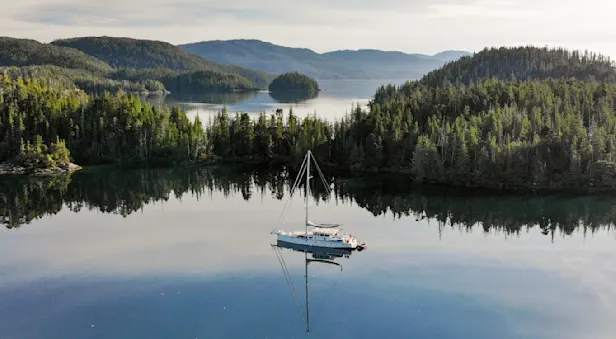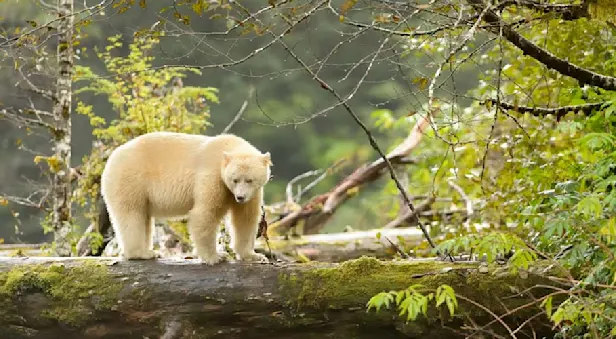Natural History of Haida Gwaii
A Land Like No Other
The Haida Gwaii archipelago has been called the “Galapagos of the North,” because its isolation from the mainland for thousands of years allowed a unique assemblage of animals to develop here. These include the world’s largest sub-species of black bear, the adorable Haida ermine and the Peale’s peregrine falcon.
The remote islands of Haida Gwaii are believed to have been a partial refugia during the last ice age—some areas remained ice-free, allowing the ecosystem to continue to evolve while the mainland was scraped bare by more than a mile of ice. Others claim the islands were covered in ice, but the ice retreated about 2,000 years earlier than on the mainland. Whichever theory is correct, the combination of Pleistocene ice and a more recent 60 miles of storm-swept, treacherous water in the form of Hecate Strait separating these islands from the mainland have created a biological treasure trove unlike anyplace else.
Humans were one of those species that were able to find an early foothold—there is evidence of human habitation reaching back nearly 15,000 years, making the Haida one of the oldest continuous cultures in the world. Caves have also preserved North America’s oldest remains of a domesticated dog, showing that this enduring relationship existed in Haida Gwaii at least 13,000 years ago.
Despite such a long history in the archipelago, the arrival of Europeans in the 1700s and their expansion in the 1800s nearly destroyed the Haida through diseases such as smallpox. Their population was quickly decimated, shrinking from as many as 30,000 to 600. Fortunately, there has been a resurgence of both population and culture on the islands in recent decades. In 2009, the colonial name in place since 1778, Queen Charlotte Islands, was erased and replaced with Haida Gwaii, “islands of the people.” The Haida Nation has wrested partial authority over the islands from the Canadian government, and towns and villages are slowly being returned to their original Haida names.
The Temperate Rainforest
The islands of Haida Gwaii are the outermost boundary of the largest temperate rainforest in the world. It accounts for one-quarter of the total remaining temperate rainforest on Earth. It covers nearly 25,000 square miles of land stretching from Vancouver Island in British Columbia to the border of Alaska. This ancient forest contains more biomass than any other terrestrial ecosystem on earth, four times the biomass found in an equal area of tropical rainforest.
The trees here can stand hundreds of feet tall and live to be well over 1,000 years old. Draped with mosses and lichens, entire ecosystems can exist on a branch high above your head. Push your arm into the mossy duff on the ground and you will likely be shoulder-deep before you reach the soil below. Look around yourself and, whether you are walking in the forest or scouring the intertidal zone, you will struggle to find a surface that doesn’t have something living on it.
Much of this life exists below ground as well. Networks of fungal hyphae—microscopic filaments that make up the bulk of the body of a fungus—connect these trees and can send water, nutrients and warnings about attacking pests from tree to tree.
Life even thrives within the needles you see. A tree with a lifespan of 1,000 years can’t adapt quickly enough to survive the threats of diseases that can mutate in a matter of weeks. Fortunately, they don’t have to. There are nimble fungi that live inside the needles acting as guards that fight off these pathogens.
This trip offers constant delights to the observant nature lover. Look closely for limpets in the intertidal zone—voracious predators whose shells are molded to fit exactly one spot on their home rock, or the delicate and beautiful twinflower on the forest floor. Then look up and take in the grand scale of a humpback whale or a high peak looming over the fjords and serpentine passages that have served as highways for Indigenous communities in canoes for thousands of years.
Why is Old Growth Forest Important?
Logging companies like to tout the fact that there are now more trees in the areas they have logged than were there prior to the original forests being clearcut. And it is true that in the Pacific Northwest, logging companies have been required to re-plant or re-seed vast areas that they cleared.
Unfortunately, these areas can barely be called forests–it would be more appropriate to call them “crops.” Today there are millions of acres of mono-culture crops of Douglas fir trees—a fast-growing evergreen that is used for everything from dimensional lumber for homes to paper pulp.
To be healthy, a forest needs a mix of trees that are of different species and ages, varying distances apart and it even needs to have standing dead trees (known as snags) and downed logs. The complexity and biodiversity of an old-growth forest develop over millennia. And it can be wiped out in a matter of days when it is clearcut.
On the most obvious level, there are significant climate impacts when you cut down massive old-growth trees and remove the carbon storage in the wood and in the soils below. But there are more subtle impacts as well.
The forest canopy shades rivers and shorelines, keeping them at the cold temperatures that salmon need to spawn and survive. Older trees support epiphytes on their boles and branches, increasing diversity and carbon storage. Amphibians rely on the functions of old growth that prevent the ground from drying out. Bird species that are adapted to the deep forest can be outcompeted by invasive “edge species” when forests are clearcut.
You will also quickly notice on this trip that much of the landscape along the British Columbia coast is steep. Really steep. And the trees are what stabilize the soil in this place that receives abundant rain (as much as 160 inches per year!). Removing the trees causes erosion that clogs the bottoms of rivers where salmon lay their eggs and makes it hard for new growth to take root on the steep hillsides.
This steepness also means that freshwater leaves the system quickly through the rivers that tumble down to the sea. Old growth slows that process, making the water available to the plants and animals that need it. A single old-growth red cedar tree can hold more than 300 gallons of water in its boughs, slowly releasing that water over time. Downed logs and thick mats of moss act as sponges to keep water in the system longer.
There is also an important feedback loop from the trees themselves. The forest is large enough to influence the weather. Transpiration, the process by which trees release moisture into the air, feeds much of the rainfall. The forest also creates cool temperatures that cause clouds to condense and rain down. When you remove the forest, you limit the amount of water available, and you turn off the air conditioner.
Death Begets Life
Another term that you will often hear thrown around by the logging industry is “over-mature forests.” It evokes a feeling of waste. A litter of dead trees and detritus that should be cleaned up to make way for younger, faster-growing trees.
But dead trees are a critical component of this ecosystem. A standing, dead tree, known as a snag, provides homes to owls, chickadees, flying squirrels, bald eagles and countless insects that feed the woodpeckers that you will hear echoing through the forest.
A dead tree that has fallen in the forest surprisingly contains more living biomass than it held when it was alive. The bulk of a living tree, the heartwood and the outer bark, is dead. The only living parts, approximately 1% of the tree, are the inner bark (the cambium), parts of the root system and the leaves, or needles.
As you walk through the forest during your time here, look at all the downed logs on the forest floor. You will see new trees growing on them, as well as mosses, fungi, ferns and more. These “nurse logs” are giving birth to new life and also act as runways for small mammals to move across the forest in search of food.
There are Forests in the Ocean, Too
You might think that the forest stops at the shoreline. However, look down into the water from the deck of our sailboat and you will see the floating bulbs of bull kelp just breaking the surface.
This submarine forest is just as important as the forest on land. This seaweed can be 120 feet tall from where it anchors to rocks on the ocean floor and can grow three feet in a single day.
Healthy, dense stands of bull kelp serve many critical functions in the nearshore ecosystem. They dissipate the energy of ocean swells, preventing waves from crashing into the intertidal zone and dislodging the myriad creatures living there. This also created safe travel routes along the shore for Indigenous canoers.
Bull kelp forests provide safe nursery areas for young fish like salmon and rockfish, helping their populations to thrive. It also absorbs carbon dioxide from the water, reducing the acidity of the water nearby, allowing snails, clams and mussels to grow strong shells. And sea otters sleep in these forests which prevent them from drifting away in ocean currents.
Gina 'Waadlux an Gud as Kwaagid—Everything Depends on Everything Else
In the 1700s and 1800s, sea otters (k_u•k_uu in the Haida language) were ruthlessly hunted for their pelts. A single square inch of a sea otter’s pelt has as much hair as an entire housecat, so they were highly valued. Over the course of these two centuries, the number of sea otters dropped from an estimated 300,000 to 2,000. This caused what is known as a “trophic cascade,” where the removal—or addition—of a species causes a cascade of impacts throughout an ecosystem.
Red sea urchins are a primary food source for sea otters. When sea otters were eliminated from the shores of Haida Gwaii, sea urchin populations boomed. Sea urchins love to eat kelp. Before long, the kelp forests disappeared from many of the coastlines of the Pacific Northwest, and they were no longer providing the critical functions listed above.
Fortunately, sea otters have been protected for the last century. After a 150-year absence from Haida Gwaii, they were first spotted again in the early 2000s. By the mid-2010s, moms and pups were spotted. Over the coming decades, their population should slowly increase, bringing the coastal ecosystem back into balance.
Go Slowly
This is a land bursting with a cacophony of life. Everywhere you look, everywhere you step, and with every mile you sail on this adventure, you will be confronted with an abundance of life that is hard to comprehend. There are few places on Earth that match the grandeur of Haida Gwaii, and it can be hard to take it all in. To truly appreciate it, move slowly, look deeply and allow yourself to be carried away by the currents of this watery realm.
See British Columbia’s Wildlife on These Trips

Haida Gwaii: Islands at the Edge of the World
Discover an archipelago of wonder off the coast of British Columbia—explore wild shorelines, ancient rainforest and 12,000 years of Haida culture on an intimate sailboat adventure in the marine wilderness.


Great Bear Rainforest: In Search of Spirit Bears, Grizzlies & Whales
Discover British Columbia at its wildest, in search of the elusive white Spirit Bear in the remote valleys of western Canada's Coast Range. Offshore, scout for humpback whales and orcas in emerald fjords.































